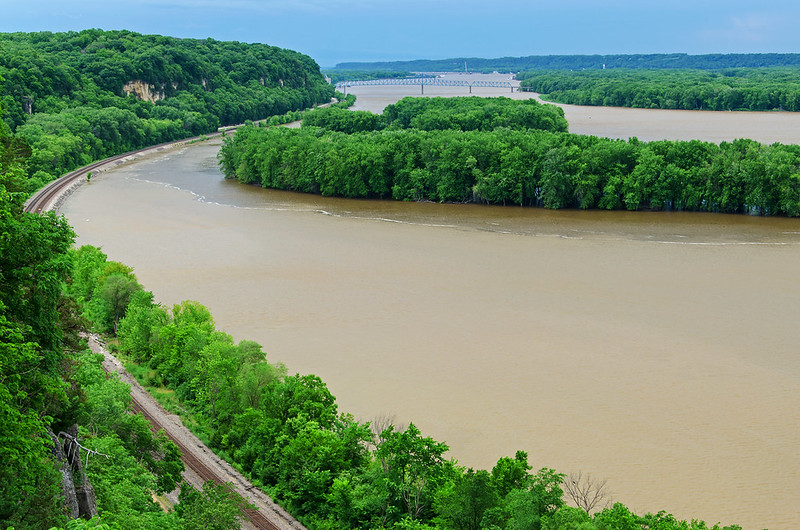 Following a rainy drive from central Illinois, we arrived at the Mississippi Palisades State Park in rather nice weather. Thunderstorms surrounded us, but never rained on us the rest of the day. The sky is a bit threatening in the distance, southeast of Savanna, Illinois - the self proclaimed "Sportsman's Paradise" on the Mississippi River. I do imagine if you're a fisherman, this is a place you'll enjoy; so many secluded inlets on the river, it would take years to explore them all. The first time we visited the Mississippi Palisades, we parked near a trail head, and hiked the trail to the observation deck, about 1/2 mile through thick, hilly forest, only to realize we could have driven to the deck and only walked 100 feet! I'd rather hike while I'm still able, but knowing about the other parking area sure makes things easy. We've taken a few of the other trails as well, and they get pretty dense - so much so that we couldn't tell if we were still on the trail or on an animal trail. Great for exploration, but watch out for ticks and mosquitoes. While the views in this park seem limited to the wooded banks of the Mississippi, and the Burlington Northern/Santa Fe railroad tracks, it's certainly a beautiful view, and worth taking in. Going to have to make this trip in the winter, when the river is frozen, and the woods are snow covered.
Following a rainy drive from central Illinois, we arrived at the Mississippi Palisades State Park in rather nice weather. Thunderstorms surrounded us, but never rained on us the rest of the day. The sky is a bit threatening in the distance, southeast of Savanna, Illinois - the self proclaimed "Sportsman's Paradise" on the Mississippi River. I do imagine if you're a fisherman, this is a place you'll enjoy; so many secluded inlets on the river, it would take years to explore them all. The first time we visited the Mississippi Palisades, we parked near a trail head, and hiked the trail to the observation deck, about 1/2 mile through thick, hilly forest, only to realize we could have driven to the deck and only walked 100 feet! I'd rather hike while I'm still able, but knowing about the other parking area sure makes things easy. We've taken a few of the other trails as well, and they get pretty dense - so much so that we couldn't tell if we were still on the trail or on an animal trail. Great for exploration, but watch out for ticks and mosquitoes. While the views in this park seem limited to the wooded banks of the Mississippi, and the Burlington Northern/Santa Fe railroad tracks, it's certainly a beautiful view, and worth taking in. Going to have to make this trip in the winter, when the river is frozen, and the woods are snow covered.
Bend in the Mighty Mississippi
 Following a rainy drive from central Illinois, we arrived at the Mississippi Palisades State Park in rather nice weather. Thunderstorms surrounded us, but never rained on us the rest of the day. The sky is a bit threatening in the distance, southeast of Savanna, Illinois - the self proclaimed "Sportsman's Paradise" on the Mississippi River. I do imagine if you're a fisherman, this is a place you'll enjoy; so many secluded inlets on the river, it would take years to explore them all. The first time we visited the Mississippi Palisades, we parked near a trail head, and hiked the trail to the observation deck, about 1/2 mile through thick, hilly forest, only to realize we could have driven to the deck and only walked 100 feet! I'd rather hike while I'm still able, but knowing about the other parking area sure makes things easy. We've taken a few of the other trails as well, and they get pretty dense - so much so that we couldn't tell if we were still on the trail or on an animal trail. Great for exploration, but watch out for ticks and mosquitoes. While the views in this park seem limited to the wooded banks of the Mississippi, and the Burlington Northern/Santa Fe railroad tracks, it's certainly a beautiful view, and worth taking in. Going to have to make this trip in the winter, when the river is frozen, and the woods are snow covered.
Following a rainy drive from central Illinois, we arrived at the Mississippi Palisades State Park in rather nice weather. Thunderstorms surrounded us, but never rained on us the rest of the day. The sky is a bit threatening in the distance, southeast of Savanna, Illinois - the self proclaimed "Sportsman's Paradise" on the Mississippi River. I do imagine if you're a fisherman, this is a place you'll enjoy; so many secluded inlets on the river, it would take years to explore them all. The first time we visited the Mississippi Palisades, we parked near a trail head, and hiked the trail to the observation deck, about 1/2 mile through thick, hilly forest, only to realize we could have driven to the deck and only walked 100 feet! I'd rather hike while I'm still able, but knowing about the other parking area sure makes things easy. We've taken a few of the other trails as well, and they get pretty dense - so much so that we couldn't tell if we were still on the trail or on an animal trail. Great for exploration, but watch out for ticks and mosquitoes. While the views in this park seem limited to the wooded banks of the Mississippi, and the Burlington Northern/Santa Fe railroad tracks, it's certainly a beautiful view, and worth taking in. Going to have to make this trip in the winter, when the river is frozen, and the woods are snow covered.
Storm Cell
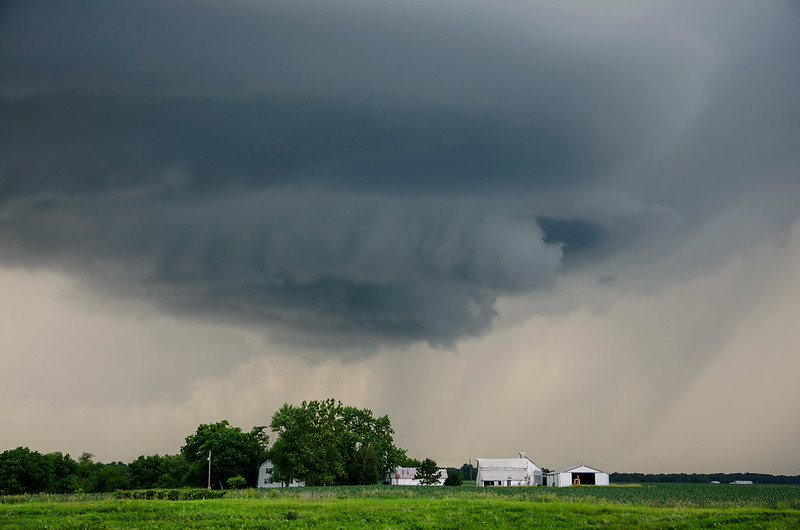
On our return trip from the Mississippi River, we noticed a storm cell forming to the north of us. It quickly developed into an interesting formation, and began dumping rain on the Illinois countryside. This cell seemed very localized, even though storms surrounded us the whole day, but it only rained on us as we drove to our second stop. Closer to home, we encountered a much larger and more intense storm, with cloud to ground lightning every few seconds, and heavy rain. Too bad it was night, and we were driving, otherwise we could have set up for some excellent lightning images.
Blackwater
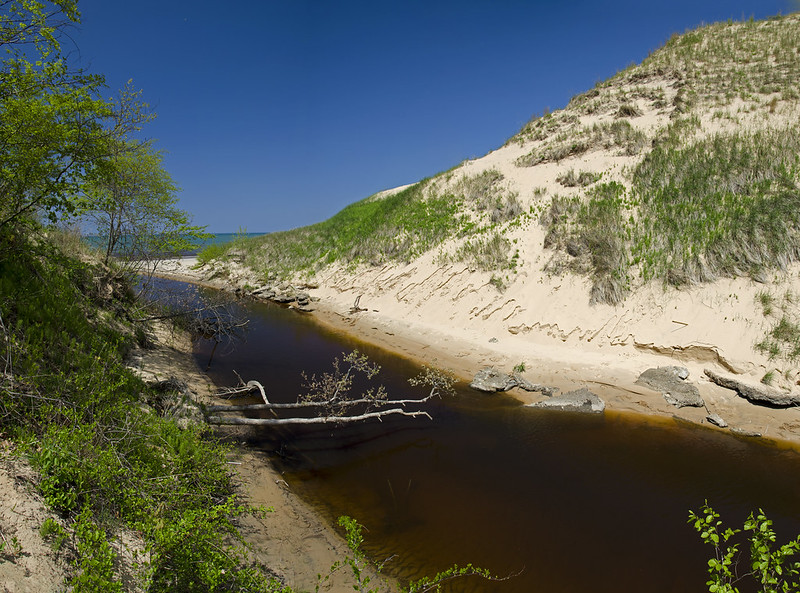 As kintzele Ditch flows through the wooded areas of the Indiana Dunes National Lakeshore, it picks up tannins from the vegetation, turning the water a deep, tea color. This is sometimes known as Blackwater. On this day, the waters provided a strong contrast to the surrounding sand dunes - especially in the bright sunlight. A favorite destination of ours, Kintzele Ditch is a short walk from Central Beach and Mt. Baldy (now closed due to last year's sinkholes). The stream is ever changing, due to the wind, and waves of Lake Michigan; sometimes the mouth of the stream changes by hundreds of feet. On days when Lake Michigan is calm, the lack of waves allows the stream to empty easily into the lake, and the tannin rich water is evident along the shore until it mixes with Lake Michigan.
As kintzele Ditch flows through the wooded areas of the Indiana Dunes National Lakeshore, it picks up tannins from the vegetation, turning the water a deep, tea color. This is sometimes known as Blackwater. On this day, the waters provided a strong contrast to the surrounding sand dunes - especially in the bright sunlight. A favorite destination of ours, Kintzele Ditch is a short walk from Central Beach and Mt. Baldy (now closed due to last year's sinkholes). The stream is ever changing, due to the wind, and waves of Lake Michigan; sometimes the mouth of the stream changes by hundreds of feet. On days when Lake Michigan is calm, the lack of waves allows the stream to empty easily into the lake, and the tannin rich water is evident along the shore until it mixes with Lake Michigan.
Chicago Harbor Light
 Built in 1893, the Chicago Harbor Light marks the entrance to the Chicago River - a waterway once vital to the Midwest. Today, the river supports mainly pleasure boaters and tours, and it's difficult to imagine industry and shipping filling the lake and river. In 1871, an attempt was made to reverse the flow of the Chicago River, so the city's sewage and waste would not flow into Lake Michigan - Chicago's source of drinking water. The reversal was made permanent when a series of locks and dams were constructed in 1900 along with the Sanitary and Ship Canal system. Today, a single lock stands between Lake Michigan and the Chicago River, just south of Navy Pier. If you're on the river, in the lock, you can watch the gates open slowly, and the water from Lake Michigan pour into the lock to equalize the river and lake levels. Once the gates fully open, the Chicago Harbor Light comes into view. The lighthouse was automated in 1979, has a third order Fresnel lens, and is constructed of concrete and cast iron.
Built in 1893, the Chicago Harbor Light marks the entrance to the Chicago River - a waterway once vital to the Midwest. Today, the river supports mainly pleasure boaters and tours, and it's difficult to imagine industry and shipping filling the lake and river. In 1871, an attempt was made to reverse the flow of the Chicago River, so the city's sewage and waste would not flow into Lake Michigan - Chicago's source of drinking water. The reversal was made permanent when a series of locks and dams were constructed in 1900 along with the Sanitary and Ship Canal system. Today, a single lock stands between Lake Michigan and the Chicago River, just south of Navy Pier. If you're on the river, in the lock, you can watch the gates open slowly, and the water from Lake Michigan pour into the lock to equalize the river and lake levels. Once the gates fully open, the Chicago Harbor Light comes into view. The lighthouse was automated in 1979, has a third order Fresnel lens, and is constructed of concrete and cast iron.
Rain on its Way
 Our voyage down the Chicago River was calm and relaxing. Aware of the threat of rain later in the day, we headed out on Lake Michigan. Once in open water, we felt the three foot waves created by the storm system a few miles west of the city. On our return trip to the river, the sky grew dark, the winds picked up, and we knew the rains were on their way. Just a few minutes after this photo, the Willis tower (I still call it the Sears Tower) disappeared - obscured by heavy rain. I told the kids I was reponsible for to come with me to the lower deck, to prepare to head inside. Moments later, the shoreline was engulfed in rain, and impossible to see; we headed below to the bar area. Seconds later, the rains hit, and all of the passengers raced to get inside - not sure why they didn't head in earlier. The bar area was packed with kids, all trying to stay dry. The winds gusted, the rain pelted the glass, and the waves crashed onto the deck and tossed the boat around a bit. Nothing huge, but each time the boat rocked, the kids screamed -not necessarily in terror, but as if they were riding a roller coaster. Some children commented that this is what it must be like aboard one of the fishing boats on Deadliest Catch (only if we were awake for 4 days, it was 70 degrees colder, had more wind, and the waves were ten times as high). The calm and prepared crew asked the children to stop screaming and to sit down on the deck so they wouldn't fall when the boat rocked. About 10 minutes later, we arrived at the Chicago River lock and the waters instantly calmed, and so did the storm. Our return to the dock was pleasant, and dry. So many of the children commented that this was the best field trip ever! A ride on a boat with a tour Chicago, and a storm at the end that tossed the boat around Lake Michigan - a great story to tell indeed.
Our voyage down the Chicago River was calm and relaxing. Aware of the threat of rain later in the day, we headed out on Lake Michigan. Once in open water, we felt the three foot waves created by the storm system a few miles west of the city. On our return trip to the river, the sky grew dark, the winds picked up, and we knew the rains were on their way. Just a few minutes after this photo, the Willis tower (I still call it the Sears Tower) disappeared - obscured by heavy rain. I told the kids I was reponsible for to come with me to the lower deck, to prepare to head inside. Moments later, the shoreline was engulfed in rain, and impossible to see; we headed below to the bar area. Seconds later, the rains hit, and all of the passengers raced to get inside - not sure why they didn't head in earlier. The bar area was packed with kids, all trying to stay dry. The winds gusted, the rain pelted the glass, and the waves crashed onto the deck and tossed the boat around a bit. Nothing huge, but each time the boat rocked, the kids screamed -not necessarily in terror, but as if they were riding a roller coaster. Some children commented that this is what it must be like aboard one of the fishing boats on Deadliest Catch (only if we were awake for 4 days, it was 70 degrees colder, had more wind, and the waves were ten times as high). The calm and prepared crew asked the children to stop screaming and to sit down on the deck so they wouldn't fall when the boat rocked. About 10 minutes later, we arrived at the Chicago River lock and the waters instantly calmed, and so did the storm. Our return to the dock was pleasant, and dry. So many of the children commented that this was the best field trip ever! A ride on a boat with a tour Chicago, and a storm at the end that tossed the boat around Lake Michigan - a great story to tell indeed.
Timid
 In honor of World Turtle Day, 2014. While walking around the yard, the boys discovered a small, Spiny Softshell turtle walking near the road, quite a distance from water. Realizing he was going to get run over or eaten by a preditor, we carried him safely in the direction he was heading, to the lake and released him. Three of them could fit in the palm of a 10 year old's hand. A few more images of turtles here from the past few years:
In honor of World Turtle Day, 2014. While walking around the yard, the boys discovered a small, Spiny Softshell turtle walking near the road, quite a distance from water. Realizing he was going to get run over or eaten by a preditor, we carried him safely in the direction he was heading, to the lake and released him. Three of them could fit in the palm of a 10 year old's hand. A few more images of turtles here from the past few years: 

 Happy World Turtle Day.
Happy World Turtle Day.
Calling
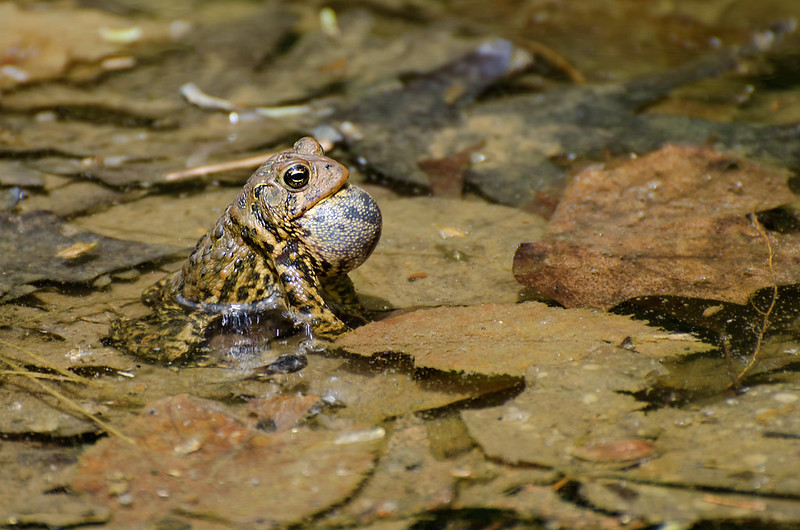 The call of large groups of frogs is one of the first real signs of Spring around this part of Illinois. Usually, as I walk by ponds and streams, the shy frogs quiet down, and hide, but this time, I decided to wait a bit for them to get used to me. After a few minutes, the frogs came out of hiding, and a bit later, one began to call for a mate. I could tell he was up to something, since he was sitting more upright than usual.
The call of large groups of frogs is one of the first real signs of Spring around this part of Illinois. Usually, as I walk by ponds and streams, the shy frogs quiet down, and hide, but this time, I decided to wait a bit for them to get used to me. After a few minutes, the frogs came out of hiding, and a bit later, one began to call for a mate. I could tell he was up to something, since he was sitting more upright than usual.If you look closely where the water meets the body of the frog, you'll see ripples in the water. These were caused by the vibration of the frog as he called. His vocal sac is displayed and in use - he wasn't bothered too much by my camera, and continued his search for a mate. Most of the other frogs in the small pond in Illinois Canyon already had mates, and were paired up in the water, oblivious to me.
Unfolding
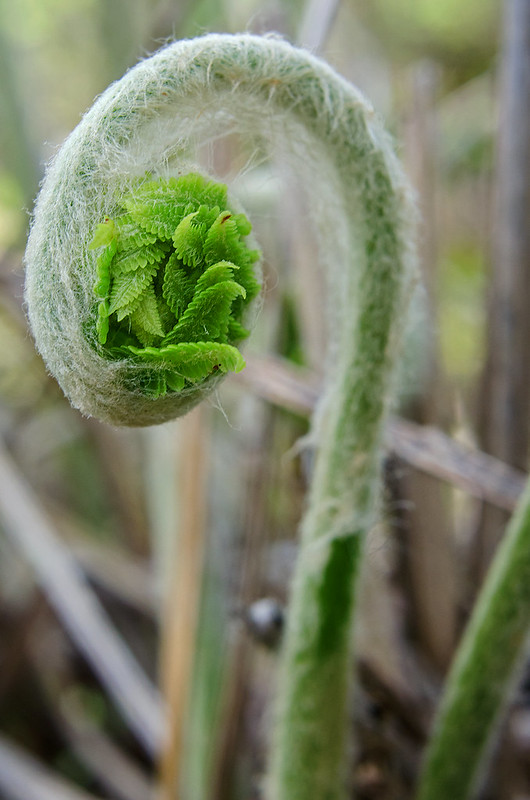
Each Spring, I visit some of the wetlands of the Indiana Dunes National Lakeshore in search of plants and animals. Of particular interest are ferns; more specifically, fiddleheads. Before the fern fronds appear, they develop in a circular roll, and slowly unroll to form a frond. These rolled up fronds are called fiddleheads, and look similar to their namesake, although I assume, the end of a violin was patterned after the fern.
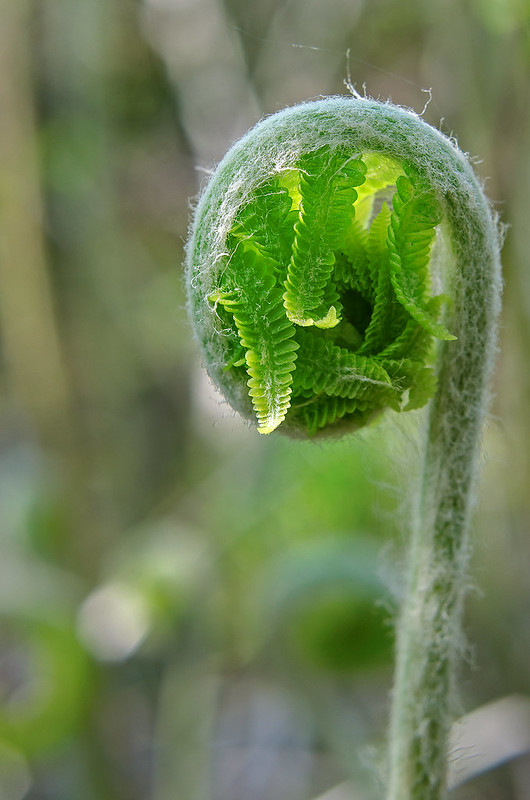
No two are exactly the same, and they don't stay rolled up for very long. What amazes me is that each of the tiny leaves of the fern is an almost exact match to the unrolled fern frond. So, the fern is comprised of fronds that are comprised of fronds. Look closely and you'll see what I mean. A sure sign that winter is over.
Cutting Through the Dunes
 Kintzele Ditch meanders through the sand dunes, on its way to Lake Michigan. The mouth of the stream is ever changing, shaped by the wind and waves, sometimes hundreds of feet up or down the shore. Out of respect for the environment, we've never managed to walk very far along this stream, and don't want to walk through it. Perhaps in a kayak one day. The short distances we are able to walk, yeild a variety of wildlife from Great Blue Heron to beaver, butterflies to ticks, as well as some interesting plantlife. This area is only a 20 minute walk from the nearest parking lots, yet it seems so remote and distant from everyday life.
Kintzele Ditch meanders through the sand dunes, on its way to Lake Michigan. The mouth of the stream is ever changing, shaped by the wind and waves, sometimes hundreds of feet up or down the shore. Out of respect for the environment, we've never managed to walk very far along this stream, and don't want to walk through it. Perhaps in a kayak one day. The short distances we are able to walk, yeild a variety of wildlife from Great Blue Heron to beaver, butterflies to ticks, as well as some interesting plantlife. This area is only a 20 minute walk from the nearest parking lots, yet it seems so remote and distant from everyday life.
Canyon Falls
 Our Spring hike through Illinois Canyon's bluebell-filled flats, required us to cross the creek three times. As the weather was relatively dry up to this point, crossing was fairly easy - using rocks and a few downed tree limbs as bridges, we made it to the head of the canyon, or at least as far as hiker's are allowed to venture. The waterfall here is very short, only a few feet tall, but quite dramatic with the winding, moss covered canyon walls. The mystery of what lies beyond this point, and the source of the creek still interest me. Perhaps in warmer weather, I'll wade through the pond to see what lies beyond.
Our Spring hike through Illinois Canyon's bluebell-filled flats, required us to cross the creek three times. As the weather was relatively dry up to this point, crossing was fairly easy - using rocks and a few downed tree limbs as bridges, we made it to the head of the canyon, or at least as far as hiker's are allowed to venture. The waterfall here is very short, only a few feet tall, but quite dramatic with the winding, moss covered canyon walls. The mystery of what lies beyond this point, and the source of the creek still interest me. Perhaps in warmer weather, I'll wade through the pond to see what lies beyond.
Spring Canyon
 Winter has finally lost her grip on the Midwest. We spent a warm, sunny afternoon at Illinois' Starved Rock State Park soaking in the sunshine and scenery. Following the long, brutal winter, nature is waking up; leaves, flowers, animals, and insects are once again commonplace on our hike. As we meandered through canyons and streams, we found several waterfalls that were still flowing from recent rains. The sounds of birds and frogs provided the soundtrack to our hike; they too were happy with the warm weather.
Winter has finally lost her grip on the Midwest. We spent a warm, sunny afternoon at Illinois' Starved Rock State Park soaking in the sunshine and scenery. Following the long, brutal winter, nature is waking up; leaves, flowers, animals, and insects are once again commonplace on our hike. As we meandered through canyons and streams, we found several waterfalls that were still flowing from recent rains. The sounds of birds and frogs provided the soundtrack to our hike; they too were happy with the warm weather.
Cobbled Ice Path
 Following the break up of the ice on Lake Michigan, some of the drift ice made it back to shore with the help of some big waves. These chunks piled up on the beach in places, then new shelf ice formed at the shore. The chunks provided an interesting cobbled path to follow into the distance, and a great place for the kids to get some exercise. We wonderd exactly where each of these chunks were formed, where they spent the winter, and how long they were adrift before landfall. Perhaps they were local, perhaps they drifted from far northern Lake Michigan. Either way, the shore of Indiana was their final resting place.
Following the break up of the ice on Lake Michigan, some of the drift ice made it back to shore with the help of some big waves. These chunks piled up on the beach in places, then new shelf ice formed at the shore. The chunks provided an interesting cobbled path to follow into the distance, and a great place for the kids to get some exercise. We wonderd exactly where each of these chunks were formed, where they spent the winter, and how long they were adrift before landfall. Perhaps they were local, perhaps they drifted from far northern Lake Michigan. Either way, the shore of Indiana was their final resting place.
Remnants of Winter
 The almost endless shelf ice mounds have all but disappeared, and liquid Lake Michigan is once again a reality. This winter hid that water under ice as far as the eye could see. Walking northeast along Washington Park Beach in Michigan City, Indiana, we encountered the last bit of shelf ice. The ice extended the length of the shore to the horizon, could this have been the southern extent of the ice that day? No more ice south, only north? It's possible. This little remnant of winter gave us the unusual opportunity to safely investigate the shelf ice up close. It was safe since the water was only about a foot deep at the end! It was still dramatic, and interesting to see the formations, as well as the physics behind pancake ice. The small waves pushed floating ice against some recesses in the shelf ice, so the ice would hit and spin, hit and spin, rounding the edges to form "pancakes." I'm pretty sure this is all but a memory now.....four days later.
The almost endless shelf ice mounds have all but disappeared, and liquid Lake Michigan is once again a reality. This winter hid that water under ice as far as the eye could see. Walking northeast along Washington Park Beach in Michigan City, Indiana, we encountered the last bit of shelf ice. The ice extended the length of the shore to the horizon, could this have been the southern extent of the ice that day? No more ice south, only north? It's possible. This little remnant of winter gave us the unusual opportunity to safely investigate the shelf ice up close. It was safe since the water was only about a foot deep at the end! It was still dramatic, and interesting to see the formations, as well as the physics behind pancake ice. The small waves pushed floating ice against some recesses in the shelf ice, so the ice would hit and spin, hit and spin, rounding the edges to form "pancakes." I'm pretty sure this is all but a memory now.....four days later.
A Challenge for Top Bird
 Standing on the last bits of shelf ice along the shore of Lake Michigan, these seagulls loudly challenge one another for the spot of top bird. Most of the Indiana Dunes National Lakeshore shelf ice has melted completely, but a rather large area of Washington Park Beach remained frozen. Possibly the southern extent of the ice at this time? Perhaps, but at any rate, it made for a very interesting walk on the beach today. The area is looking a lot more like Spring now, with wildlife awakening, sand visible, boats on Lake Michigan, and bulldozers replacing the sand blown into the parking lot over the winter. Soon, the beach will swarm with sunbathers and swimmers; can't wait.
Standing on the last bits of shelf ice along the shore of Lake Michigan, these seagulls loudly challenge one another for the spot of top bird. Most of the Indiana Dunes National Lakeshore shelf ice has melted completely, but a rather large area of Washington Park Beach remained frozen. Possibly the southern extent of the ice at this time? Perhaps, but at any rate, it made for a very interesting walk on the beach today. The area is looking a lot more like Spring now, with wildlife awakening, sand visible, boats on Lake Michigan, and bulldozers replacing the sand blown into the parking lot over the winter. Soon, the beach will swarm with sunbathers and swimmers; can't wait.
The Last Grip

Probably the last of winter's grip on the St. Joseph, Michigan lighthouses and channel markers. Over the winter, ice built up on the concrete piers marking the banks of St. Joseph River - in places, feet thick. The increasingly sunny days bring with them warmth and the ability to melt this coating, once again revealing the structures underneath.
The piers were lined with fishermen, the shore dotted with seagulls and eager beach-goers, and the lake with melting drift ice. Warmer weather, and storms this week will almost certainly eliminate the last of winter's creations.
The Melting

Winter finally begins to release its grip on Lake Michigan, as the ice begins to melt. Still extending to the visible horizon, the ice is giving way to a bit of water, creating some interesting formations along the shore.
Full sun, and temperatures reaching 50 degrees Fahrenheit made the walk on the beach comfortable - after 4 months of dashing through frigid weather. The St. Joseph, Michigan pier was swarming with people, walking, biking, and fishing; probably the first outings for most this year. It felt great to walk in sand again, rather than ice and snow.
Icy Expanse

Looking more like a scene from the Great Salt Lake, or a volcanic vent, the shore of Lake Michigan is in a thawing state. The mounds of shelf ice a few hundred feet off shore appear like mountains in the distance, while the melting ice at the shore has the look of mineral deposits, with jagged edges leading to cavernous spaces beneath the water.
The melting ice near the shore created some beautiful patterns on the edges; looking rather delicate, it could support my weight. This melting just began, and we only noticed it in a small area of the beach. Each day, will change this "landscape" drastically, until the ice is gone.
As cold as the water was, I felt the need to wade in just to experience the floating ice highlighted by the sun and shadows. Ultimately, I resisted. I do, however, wish to bring along a kayak next time, to paddle in the water next to and between the mounds of ice.
Dune Patterns

Partially obscured by high clouds, and the dunes, the early morning sun highlights the wind-blown patterns in the freshly fallen snow. Our first steps onto the beach after walking a few miles from the nearest parking area, and between these two dunes, were into the thigh-deep snow. Solid in places, we'd fall through every few steps, making the hike a bit of a chore.
We walked as fast as possible to get to a legal place to climb the dunes before the distant clouds rolled in. As it turned out, after a long while on the top of the ridge, the clouds disappeared for the rest of the day, making the waters of Lake Michigan deep blue, and the drift ice bright white.
Horizontal Bands
The deep blue waters of Lake Michigan, drift ice, shelf ice, sand, and snow create interesting bands of color and texture along the beach. A relatively warm day allowed some of the ice on the lake to melt, a sure sign of Spring. The snow will disappear soon as well, but the 15 foot tall mounds of shelf ice can take weeks to melt.
As much as I dislike cold weather, winter is a magical time on the Great Lakes. After hiking miles to reach locations for photographs, I often remain, soaking in the atmosphere - quiet solitude. I'm almost always the only person in sight, and from some vantage points, I can see for miles.
Once summer arrives, I'm rarely the only person in sight - unless I seek some of the relatively unknown places at the Indiana Dunes National Lakeshore, which I often do.
The Break Up, From the Ridge
This winter, most of the lakefront access areas I frequent, were closed, preventing me from viewing the frozen lake. The main issue with the closings, was parking- there was nowhere close to park. Having been to these beaches every winter for years, I was determined not to break the streak, so we found the nearest parking area, and hiked in about three miles one way.
It was a relatively warm morning, with stiff winds blowing in, and fading sunshine. We managed to climb the snow covered dune safely (and legally), and were greeted by this view.
Previously, ice covered Lake Michigan as far as the eye could see, but with the recent warm temperatures and high winds, the ice began to break up. The shelf ice, however, isn't going anywhere for some time. From approximately 80 feet above the beach, we could see the extent of the 15 to 20 foot tall shelf ice mounds, and the deep blue, open water.
Well worth the hike and the climb, we experienced the beach in winter - one of my favorite times to visit - with no other people in sight for miles. After capturing photographs, we remained on the ridge for some time, just to soak in the experience.
On to the next place, it was only 8:00 am....
Subscribe to:
Posts (Atom)

